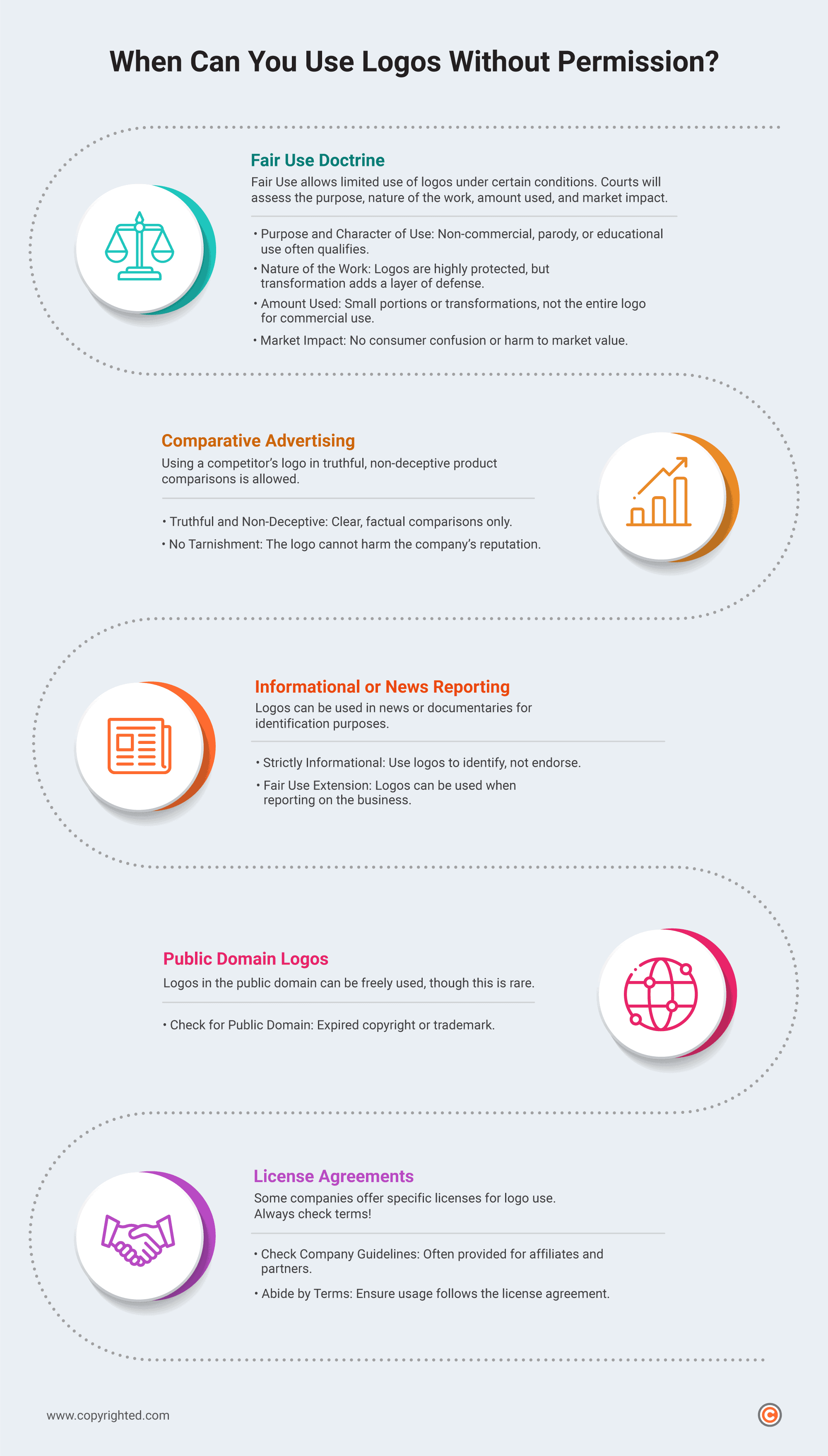Logos are everywhere, from the clothes we wear to the devices we use. They serve as recognizable symbols for companies and brands.
But can you use the logo of another company without their permission? The simple answer is no—logos are protected by copyright and trademark laws, and using them without approval can lead to legal issues.
In this article, we’ll explain when you can use logos, what happens if you don’t have permission, and situations where it may not be required. Whether you’re a business owner, content creator, graphic designer, or just curious, this guide will clarify the legal aspects of logo use.
- You generally cannot use copyrighted logos without permission, as they are protected by copyright and trademark laws.
- Unauthorized use of a logo can result in legal, financial, and reputational consequences, including lawsuits and damages.
- Certain exceptions like fair use, comparative advertising, and news reporting may allow limited logo usage without permission under specific conditions.
Table of Contents
Can You Use Copyrighted Logos Without Permission?
No, you generally cannot use copyrighted logos without permission.
Logos are protected under both copyright and trademark laws, giving the copyright or trademark owner exclusive rights to their use. This protection means logos cannot be reproduced, distributed, or publicly displayed without consent.
Under copyright law, logos can qualify as original works of authorship as long as they exhibit a minimal level of creativity, protected by 17 U.S.C. § 102. The law protects the expression of the idea, or the design of the logo, rather than the idea itself.
This means that any unauthorized reproduction or public display of the logo could result in a copyright infringement claim.
Logos are also often protected under trademark law through the Lanham Act, serving as brand identifiers. Unauthorized use that causes consumer confusion about the source of goods or services can infringe on the trademark and lead to a claim.
What Happens if You Use Copyrighted Logos Without Permission?
Using a copyrighted logo without permission can lead to several significant consequences, both legal and financial, as well as potential damage to your reputation.
If you’re unsure about logo usage, it’s wise to consult a copyright infringement or trademark lawyer who can guide you through the legal risks and help you avoid potential claims.
Here’s an expanded look at the possible outcomes:
Legal Consequences
Unauthorized use of logos can lead to copyright or trademark infringement claims. Under 17 U.S.C. § 501, copyright infringement occurs when you use a copyrighted work without permission.
Similarly, under 15 U.S.C. § 1114, using a trademarked logo in a way that causes consumer confusion can result in a trademark infringement lawsuit. Possible outcomes include:
- Cease and Desist Orders: You may be required to stop using the logo immediately.
- Lawsuits: Copyright infringement penalties range from $750 to $150,000 per infringement, while trademark cases may result in damages or profits gained from unauthorized use.
- Injunctions: Courts can order you to remove the logo from all materials.
Financial Consequences
If found liable for copyright or trademark infringement, you could face severe financial penalties, including:
- Damages and Compensation: You may owe statutory damages or the profits gained from using the logo.
- Legal Fees: You could also be required to cover the logo owner’s legal costs.
- Settlement Costs: Settling out of court may still involve expensive fees.
Reputational Damage
Aside from legal and financial consequences, unauthorized use of a copyrighted or trademarked logo can harm your business’s reputation, such as:
- Loss of Credibility: Your business may appear unethical, affecting relationships with customers and partners.
- Customer Trust: Customers may lose confidence in your brand if they see you violating intellectual property laws.
Criminal Penalties
Criminal penalties may apply in cases of willful infringement, including fines of up to $250,000 and up to five years in prison.
When is Permission Not Required to Use Logos?

In specific situations, you do not need permission to use a copyrighted or trademarked logo from the brand name owner.
These instances are typically governed by legal doctrines such as fair use, comparative advertising, and certain licensing agreements. Each of these exceptions comes with specific conditions, and misuse outside these contexts can still result in legal consequences.
Here’s a breakdown:
Fair Use Doctrine
The Fair Use Doctrine allows limited use of copyrighted materials, including logos, without written permission from the owner. However, fair use applies under specific conditions and is evaluated case-by-case.
The following factors are considered in determining whether the use of a logo qualifies as fair use:
- Purpose and Character of Use: Non-commercial, educational, or commentary purposes like parody and criticism may qualify as fair use.
- Nature of the Work: Logos may receive more protection due to their creative nature, but transformative use that adds new meaning can support a fair use defense.
- Amount Used: Using only a small, non-identifying portion of the logo may be considered fair use, but copying the entire logo for commercial purposes likely won’t.
- Market Impact: If the logo’s use harms the market value or confuses consumers, it’s less likely to be fair use.
Comparative Advertising
In comparative advertising, businesses may use their competitor’s logos to compare products or services as long as the use is not deceptive and does not mislead consumers. This practice is protected under 15 U.S.C. § 1125.
Key requirements for comparative advertising include:
- Truthful and Non-Deceptive: The comparison must be truthful and not imply a false affiliation.
- No Dilution or Tarnishment: The logo’s use must not damage the company’s reputation.
Informational or News Reporting
Logos may also be used in news reporting or informational content like articles or documentaries. This is another application of fair use, where the logo is used to identify the company being discussed.
For instance, news outlets can show a company’s logo when reporting on that business without permission, as long as the use is strictly informational.
Public Domain Logos
If a logo is no longer protected by copyright or trademark (for example, if it has expired), it may fall into the public domain. Once in the public domain, the logo is no longer under legal protection, and anyone may use it without permission.
However, this is rare for logos, as companies often renew trademark registrations to maintain control over their brand.
License Agreements
Some companies may offer license agreements that allow third parties to use their logos under specific terms and conditions. For instance, businesses may provide logo use guidelines for affiliates, partners, or vendors, detailing how and where the logo can be used.
Before using a logo, check if the company offers a license or provides usage guidelines. Failing to comply with these terms can still lead to legal action, even if explicit permission was initially granted.
Frequently Asked Questions
Can you use a modified version of a copyrighted logo without permission?
No, modifying a copyrighted logo without permission is still considered infringement, as the design remains protected.
Is it still considered copyright infringement if you modify the logo?
Yes, even modifying a logo can be considered copyright infringement if it retains identifiable elements of the original design.
Can you use another company’s logo on your website?
You cannot use another company’s logo on your website without permission unless it qualifies as fair use, such as for commentary or news reporting.
Can you use a copyrighted logo on social media for your business promotions?
No, using a copyrighted logo on social media for promotions without permission could result in legal consequences.
How can you determine if a logo is copyrighted or trademarked?
You can check the U.S. Copyright Office or the United States Patent and Trademark Office (USPTO) databases to determine if a logo is copyrighted or trademarked.


